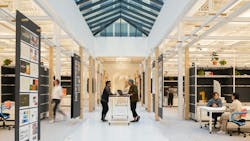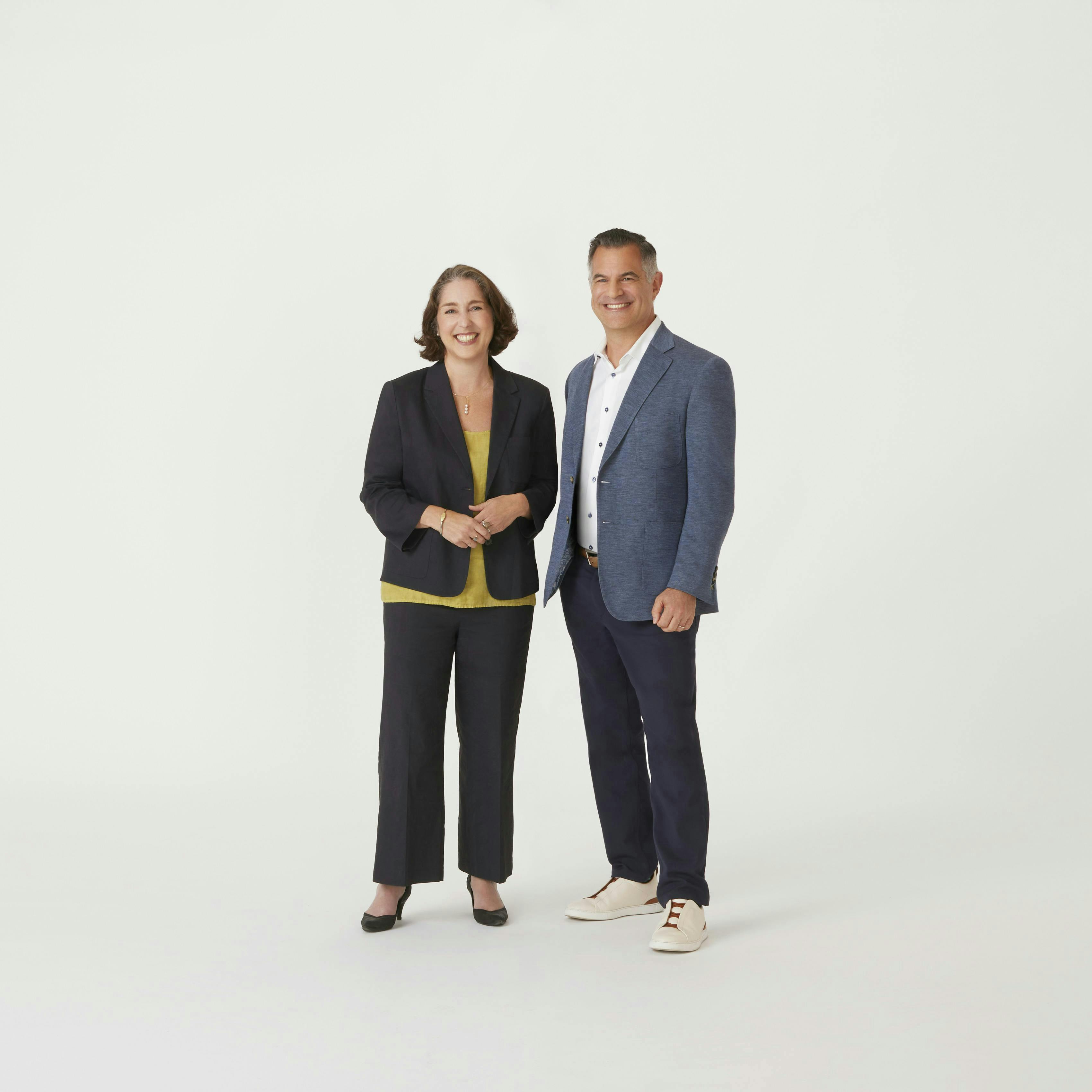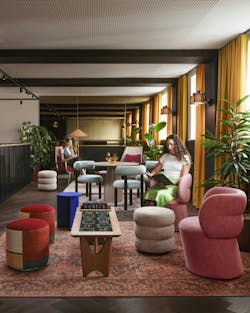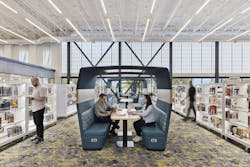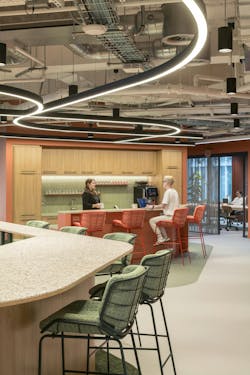Gensler’s 2025 Design Forecast: Shaping a Vibrant, Sustainable Future
The start of a new year typically brings with it a sense of hope for new beginnings. And in a rapidly evolving world rife with challenges for the built environment, a healthy dose of optimism is much needed for the design practitioners who are striving to make a positive impact on people and the planet.
Fortunately, the outlook for the industry is positive if you ask the folks at global architecture and design firm Gensler. Each year, the leaders of the award-winning firm release their highly anticipated Design Forecast report that delves into the key trends shaping the architecture and design industry—and 2025 is no exception.
i+s Chief content director Robert Nieminen recently sat down with Jordan Goldstein and Elizabeth Brink, co-CEOs of Gensler, for an episode of the “I Hear Design” podcast to explore the pivotal themes of their latest forecast. Brink and Goldstein shared the reasons for their optimism, citing the transformative power of design in addressing the global challenges we face.
Following is an edited version of the conversation, presented here in a Q&A format. (To listen to the episode in its entirety, visit the podcast landing page.)
i+s: The Gensler 2025 Design Forecast opens with a sense of optimism. What are the key drivers behind this positive outlook?
Elizabeth Brink: The sense of optimism—this key thing about the human experience, creating adaptable spaces that really prioritize the human experience and a sense of community, and driving more sustainable solutions—that’s coming from the ground up. That’s really coming from what we’re hearing at the project level, working directly with our clients in our communities and our cities. That shift we’re seeing—one of the things driving so much of that optimism—is that shift toward people really wanting to activate their environment. Whether it is their workplace, their cities, or their communities, they want to have spaces and places that serve the needs of people and that inspire people to really come together.
Designing something that could be better is really an inherently optimistic act for all of us, and we lean into that. As designers, we see a problem, we want to go solve it. We want to figure out how to make things better. What’s really wonderful, what we’re seeing this year more than ever before, is so many of our clients wanting to come along with us on that journey. They’re leaning into us to be those creative, optimistic, problem-solving partners. You’re seeing that come through in the design forecast—that people want to come off the sidelines and really be creating and making these spaces. It is really a transformational time that we’re excited about.
i+s: What are the five trends shaping design in 2025 identified in Gensler’s Design Forecast?
Jordan Goldstein: We feel like there are five trends that have really risen to the top, and we highlight those in the Design Forecast. The first is the notion of experience-driven lifestyle districts. This is about reimagining our cities with vibrant, mixed-use destinations that connect people through immersive, engaging experiences. It’s no longer about sole-purpose parts of the city—it’s about that meshing together in a very differentiated recipe.
The next one is a strong demand for sustainable design. We’ve talked about sustainability over the years, but this year we feel like innovations in materials and building processes are addressing climate risks and driving value. We believe this focus in 2025 will be a differentiator.
The next is around conversions—the adaptive reuse boom. We believe it’s going to take off at an amazing scale in 2025. This is about creative conversions of aging buildings as economic and environmental imperatives—bringing new life to old bones. It’s not necessarily just office to residential, which has certainly been out there, but it’s office to office, office to clinic, retail to sports and entertainment, retail to health and wellness.
The fourth is attainable housing—tackling the global housing crisis with actionable policies and inventive design. We believe 2025 will see a real step up in the attainable housing conversation.
And then the fifth one is around the future workplace. There’s always a discussion about what’s going to happen in the workplace in the next year. Our feeling is that the future workplace is now. We’re seeing workplace design prioritize employee experience and align with expectations, both from individuals going into the workplace and tenant demands.
i+s: How is sustainable design driving innovation in 2025?
JG: In 2025, sustainable design is going to be a driving force in real estate. Environmentally conscious buildings are commanding top value and reinforcing the flight to quality—differentiated buildings that tell a story people can connect with, whether personally or in alignment with company values.
In terms of advancements, the zero-carbon and low-carbon cement revolution that’s out there right now is going to see a lot of traction. Low-carbon interior finishes, certainly mass timber—the ability for that to enter different markets at more competitive price points—and prefabrication and robotics are all contributing to this story.
For us, we created Gensler’s Product Sustainability Standards. We felt there needed to be a baseline threshold for materials and finishes to be considered for projects. That baseline sets sustainability guidelines for materials in our library, and our hope is that this creates a ripple effect through the industry—prompting manufacturers, vendors, and distributors to align with this thinking.
It’s not just about the materials themselves, though—it’s about the strategies and combinations of materials and systems that enhance sustainability. Adaptive reuse strategies for buildings, weather scenario planning when looking at sites, modular construction, prefabrication, and advancements in robotics will drive the carbon footprint story.
i+s: Adaptive reuse is a major focus of the report. Can you share examples of how this will play out?
EB: Understanding conversions as part of fundamental sustainability strategies, particularly the structural aspects of buildings—that’s one of our key strategies for creating resilient, sustainable cities. We’re seeing this in everything from office-to-residential conversions, which have been widely talked about.
We’re also seeing big-box retail conversions. These spaces, which have dotted the landscape for years, are being converted into office spaces that utilize those large volumes to create unique environments. Sustainable features like bringing natural light deep into the buildings are added during the conversion process. It really runs the gamut of possibilities.
JG: Elizabeth and I are also excited about the opportunities in sports and entertainment conversions—big boxes becoming sports destinations, live music venues, or cultural and rehearsal spaces. There’s real creativity emerging in this space. It combines sustainability and opportunity to rethink what these buildings can be.
i+s: How is Gensler redefining the workplace for 2025?
JG: The workplace is no longer just a place to work—it’s a space to build culture, support employees, and to get mentorship. That was certainly something we all saw and that was missing during the COVID years. We feel like in 2025 […] tenants will continue to choose premium, amenity-rich buildings, and landlords will be looking to compete. In that landscape they will need to be really laser focused on bringing these types of spaces and places to the marketplace, so we’re already seeing that.
EB: I think during the COVID time period, we evolved in our relationship with clients, and we really leaned in and created some really deep relationships with them trying to understand their workforce, what their people need, what their businesses need, and how they can be navigating this changing time.
What we’re now saying is the workplace of the future is here because we’ve gone through this period of experimentation and working. As trusted advisors with those clients, it is so much more about what a specific office needs, what a specific organization needs, and what they’re trying to achieve with their people than a standard set of solutions that should be applied for everybody. It’s that partnership that has allowed us to really be pushing forward in terms of the work we’re doing in the workplace and creating those spaces that are, as Jordan said, the destinations that people want to be coming to and want to be spending time in.
i+s: What actionable insights do you hope architects and designers take away from the forecast?
JG: So the wonderful conversation that we’ve been having now for many years around sustainability is it’s not the people’s responsibility that are sitting over there. [It’s] something that everyone leaning into that which creates a true change and really can create that ripple effect. So, certainly as designers, we feel like we have a responsibility to bring that thinking to the table. But being able to then have a dialogue with those around the table that recognize the value, the importance, and that it doesn’t necessarily mean wholesale change; it may mean that just thinking differently about one thing could have a significant impact on the larger whole.
EB: It’s taking action, but that action could be having a dialogue. It could be considering a new way of thinking about something. It could be having that extra conversation around a sustainable strategy or bringing a creative solution to housing or a conversion. “How could we convert this space rather than tear it down?” into the dialogue. It can really be about bringing any of that into the dialogue.
To explore Gensler’s “5 for ‘25” trends further, visit gensler.com and download the full report.
About the Author
Robert Nieminen
Chief Content Director
Chief Content Director, Architectural Products, BUILDINGS, and interiors+sources
Robert Nieminen is the Chief Content Director of three leading B2B publications serving the commercial architecture and design industries: Architectural Products, BUILDINGS, and interiors+sources. With a career rooted in editorial excellence and a passion for storytelling, Robert oversees a diverse content portfolio that spans award-winning feature articles, strategic podcast programming, and digital media initiatives aimed at empowering design professionals, facility managers, and commercial building stakeholders.
He is the host of the I Hear Design podcast and curates the Smart Buildings Technology Report, bringing thought leadership to the forefront of innovation in built environments. Robert leads editorial and creative direction for multiple industry award programs—including the Elev8 Design Awards and Product Innovation Awards—and is a recognized voice in sustainability, smart technology integration, and forward-thinking design.
Known for his sharp editorial vision and data-informed strategies, Robert focuses on audience growth, engagement, and content monetization, leveraging AI tools and SEO-driven insights to future-proof B2B publishing.
